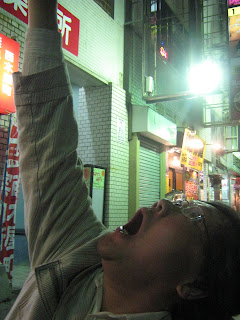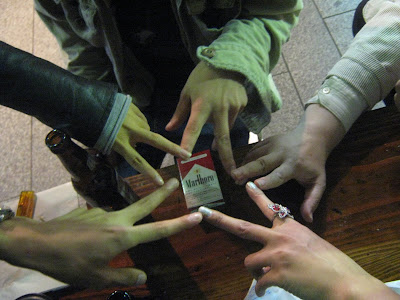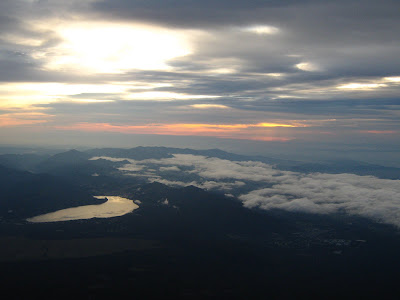 Some aspects of the culture seem very traditional and unchanged such as the formal way dinner is sometimes presented at a Japanese household. Some nights I've had are just like being in any other multi-cultural cosmopolitan city, albeit with a distinctly Japanese flavour.
Some aspects of the culture seem very traditional and unchanged such as the formal way dinner is sometimes presented at a Japanese household. Some nights I've had are just like being in any other multi-cultural cosmopolitan city, albeit with a distinctly Japanese flavour.
My original thoughts about Japan was that it had such an interesting experimental music and art scene that it would be easy to meet japanese people who have similar interests to myself, in wierd and wonderful culture.
 I have discovered however that the majority of people I meet are only interested in the latest pop song, or talent/idol that the media is pushing at the time. Perhaps this has something to do with the Gaidai bubble but I get the impression that it is like this all over Japan. What this seems to do however is create extremely niche sub-cultures where the people who love it, really, really love it, and the people who make it are phenomenally talented. Japan for me is also the land of the spectacle, where thousands of people will commute to see different coloured leaves, or some gates with lights on them. (I mean yeah they're pretty, but which other country in the world makes an effort to brave the massive crowds, just to go and stand under some lights with your mates?!?)
I have discovered however that the majority of people I meet are only interested in the latest pop song, or talent/idol that the media is pushing at the time. Perhaps this has something to do with the Gaidai bubble but I get the impression that it is like this all over Japan. What this seems to do however is create extremely niche sub-cultures where the people who love it, really, really love it, and the people who make it are phenomenally talented. Japan for me is also the land of the spectacle, where thousands of people will commute to see different coloured leaves, or some gates with lights on them. (I mean yeah they're pretty, but which other country in the world makes an effort to brave the massive crowds, just to go and stand under some lights with your mates?!?)  For me these types of events seem to be more about connecting with people rather than the event itself. With some aspects of Japanese culture being so rigid, such as social interaction, these events may act as the social-lube required on a date with someone that you dont know very well. Or maybe it is true that Japanese people appreciate the aesthetic beauty more and so gain a greater fullfilment from visiting them.
For me these types of events seem to be more about connecting with people rather than the event itself. With some aspects of Japanese culture being so rigid, such as social interaction, these events may act as the social-lube required on a date with someone that you dont know very well. Or maybe it is true that Japanese people appreciate the aesthetic beauty more and so gain a greater fullfilment from visiting them.









 One of the most interesting things for me about Japanese religions is that they dont have just
One of the most interesting things for me about Japanese religions is that they dont have just 

 This weeks topic is sexuality and gender in Japan, and I have chosen to discuss the sexualized figurines and toys which are available in almost every populated area of Japan that I have traveled to thus far. In Japan women are objectified and sexualized, often to the point of ridiculousness, this can be seen in hundreds of media formats including magazines, T.V. shows and advertising, but the thing that shocks me the most is the hyper-sexualization of figurines found in gacha gacha (capsule toy) vending machines and figurine shops.
This weeks topic is sexuality and gender in Japan, and I have chosen to discuss the sexualized figurines and toys which are available in almost every populated area of Japan that I have traveled to thus far. In Japan women are objectified and sexualized, often to the point of ridiculousness, this can be seen in hundreds of media formats including magazines, T.V. shows and advertising, but the thing that shocks me the most is the hyper-sexualization of figurines found in gacha gacha (capsule toy) vending machines and figurine shops.


 BIKKURI DONKEY(which means Suprise Donkey) is the name of this restaraunt in Kobe and it was a hamburger joint with a Japanese Twist. The tractor and the American numberplates in the background are obviously
BIKKURI DONKEY(which means Suprise Donkey) is the name of this restaraunt in Kobe and it was a hamburger joint with a Japanese Twist. The tractor and the American numberplates in the background are obviously












